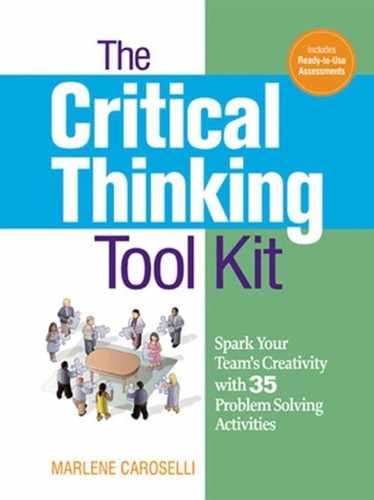#25: Crises Critiques
Overview: |
Participants will work in small groups on a number of problems that call for careful analysis. Each group will then create a checklist of steps to be taken when corporate crises occur. |
Objective: |
• To provide practice with problems requiring critical thinking. |
Supplies: |
• Copies of Worksheet #25-1, one per participant |
Time: |
35–45 minutes |
Advance |
Makes copies of Worksheet #25-1. Put tables and chairs into formations that allow four or five participants to work together. |
Participants/ |
This exercise, which works with any number of participants, can be employed at any time during the instructional day. As an opener, it stimulates collaboration among participants and underscores the need for participants to use critical thinking throughout the training session (no matter the topic). As an energizer, it is a good change-of-pace activity, bound to reawaken interest because of its real-world familiarity. As a session-closer, it reinforces the need for participants to think analytically when they return to the workplace, where crises invariably occur. |
Introduction to Concept:
The unofficial “Wizard of Spin” is Michael Sitrick, who is best known for his crisis management resolutions. If ever a situation requires critical thinking, it is when a crisis has erupted and needs to be contained. Companies that take action without analysis can put their very existence into jeopardy. Sitrick cites the case of the executive who denied a reporter’s implication that the company was having trouble paying its vendors. His denial was based on truth—the company was not having cash flow problems. Vendors were receiving monies that were due them. However, when the story broke, the denial caused vendors to wonder if perhaps they were about to start receiving late payments. The company wound up bankrupt.
The spin doctor would have advised the executive to ask the reporter which vendors were making this claim. The executive could have then uncovered the actual problem and could have reported that to the journalist—probably the same day. In the interim, he could have given the journalist the names of dozens of other vendors who were satisfied with payment schedules.
There are many ways to report truth. But for a cynical public, the most believable truths are usually not those that claim un-truths are untrue. Today, you and your teammates will have an opportunity to play CEO-for-a-day. After specifying how you would react to each of these real-world scenarios, you will formulate a plan of action for crisis situations in general.
1. Distribute Worksheet #25-1. Allow 15 to 20 minutes for small groups to complete the assignment.
2. Have each small group join another small group to exchange action plans and then to prepare a composite action plan, synthesizing the best of each original. The synthesized plans will be printed on a blank transparency.
3. Have a spokesperson from each group of 8–10 present their action plans to the group at large.
4. Share with the class the fact that all of the case studies actually happened to Procter and Gamble, Chesterfield, and General Foods, and were handled with varying degree of “critical” success.
Extending the Activity:
1. Interview the CEO of the organization sponsoring the training you are presenting. Learn about crises that have arisen in the organization’s history. Use these as the basis for a comparable worksheet.
2. Invite the head of a public relations firm to the class to critique the action plans the teams have created.
Workplace Connections:
1. Ask each participant, upon his or her return to work, to fashion a response to this question: “What is the worst thing that could happen here?” Next, he or she should describe the steps that would prevent the crisis or, if it is unavoidable, to outline the steps that would reduce the severity of the consequences. These plans should then be shared with upper management if comparable plans do not already exist.
2. Encourage post-class benchmarking to learn what plans other organizations have in place.
Questions for Further Consideration:
1. If the head of your organization were to do your job for just one day, what would he or she learn? What would most surprise the person?
2. How prepared do you feel your organization is for crises in the workplace?
A. Assume you are the head of a successful company that produces household products. Suddenly, you find the entire country talking about your logo, a moon with stars clustered around it. The talk has an ugly tone—people are saying the symbol represents Satan. You fear the public will lose faith in your product. On the other hand, you have worked hard to achieve that well-recognized corporate identity. What specific steps would you take to battle the rumors?

B. It is 1934. You are CEO of a cigarette company. While you know that heavy cigarette smoking produces a bad cough in some smokers, you are certain smoking does not produce leprosy. Nonetheless, a rumor is rapidly spreading that your company in Richmond, Virginia, has employed a leper and that people who smoke the cigarettes he has touched are getting leprosy. What, specifically, would you do to counter these untruths?

C. The new product, a carbonated candy, looked like a dream come true. Soon after its introduction, however, stories began to travel across the country that the candy exploded in the digestive system. What would you do to counter the false claims of sickness and death?

Having considered three specific scenarios, prepare an action plan detailing what steps should be followed, generally speaking, when crises occur at your company.

